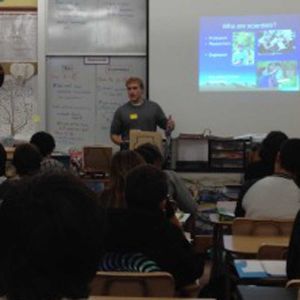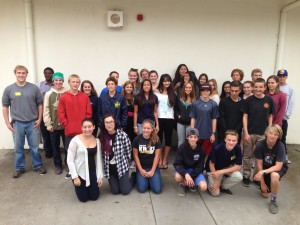By Wesley von Dassow | Pasante del PCP PIRE Verano 2014
Upon arriving in California to do classroom visits I had little idea what to expect. There were two scenarios I had in mind. One scenario was that students would be attentive, ask questions leading to good conversations and, if time permitted, we would conclude with a prepared geologic puzzle. The other was that students would be rowdy, hard to attract the attention of, possibly quiet and disinterested, a group that I would essentially be talking at instead of actively conversing with.

In reality, I experienced a mix of these two scenarios. Some classes contained students who were genuinely interested, or at least asked questions to meet their participation requirements, which led to interesting topics of discussion. Others, especially a group of freshman biology students, were completely blasé and had to be goaded or prompted into asking questions at all. By far the most entertaining were a group of eighth grade chemistry students who I permitted to ask me personal questions for a short period (I assumed they would be more along the lines of “how much did college cost?” and not “Do you have a girlfriend?”) before we dialed in on our subject of focus again. However, no matter the context or the level of engagement I realized that to some extent, most of the students found at least something I said interesting or pretended it was cool when we talked casually at the end of class, or later during my visit.
Personally, I discovered that I not only enjoy sharing geology with students—especially interested ones—but that students are clearly capable of handling the material if the curriculum were to include a more thorough covering of earth science. This was evident even in the youngest students I addressed through some of the questions they asked.
What I really hope these students take away from my speaking with them is the importance of getting volunteer experience in high school and being able to get to college. It was clear to me that most of them hadn’t received much advising to that respect and some of the teachers reflected that with regret that those resources weren’t more readily available.

I enjoyed what I did in Santa Cruz and I definitely hope to be able to continue doing this work. Particularly, I would like to help solve the problem of providing resources to students interested in future opportunities, like college, and ways to get them there. Part of this is because it’s apparent that, at least the dedicated teachers I’ve had the pleasure of working with this week, are already doing a great job in teaching these students. It’s inspiring to see them in and outside of the classroom working their butts off spending multiple hours to prepare a one hour activity. It’s even more inspiring to know they do this while dealing with administrative pressures on the other end.
Finally, over several evenings, Sean Moran and I had the opportunity to show some teachers an awesome fossil site at Capitola Beach—further testament to the lengths these folks go to in order to do their job well. While there, Sean and I described the geologic history of the rock, identified the fossils that were present, and explained how the fossils likely got there. Although this hasn’t lead directly to a lesson plan as yet, it was a great jumping off point for where these ideas might fit in the classroom and what activities would be possible. Being with teachers in their classrooms, working with their students, and engaging teachers outside the classroom helped me understand why people get into teaching. Hopefully one-time visits by scientists have the potential of shaping a student’s perspective on the future.
Click here for more about Wes’ visit.
Por Wesley von Dassow | PCP PIRE Summer 2014 Intern
Al llegar a California para hacer visitas de aulas, tenía poca idea de qué esperar. Habían dos escenarios que tenía en mente. Un escenario era que los estudiantes estarían atentos, harían preguntas que conducirían a buenas conversaciones y, si el tiempo lo permitía, concluiríamos la clase con un rompecabezas geológico que habíamos preparado. El otro escenario era que los estudiantes serían ruidosos, difíciles de atraer, quizás callados y desinteresados; un grupo al que esencialmente estaría hablando en vez de un grupo con el que estuviera conversando activamente.

En realidad, yo experimenté una mezcla de estos dos escenarios. Algunas clases contenían estudiantes que estaban realmente interesados, o que al menos hicieron preguntas para satisfacer sus requisitos de participación, lo que llevó a temas interesantes de discusión. Otros, especialmente un grupo de estudiantes de biología de primer año, fueron completamente indiferentes y hubo que pellizcarlos o incitarlos a hacer preguntas. De lejos, el grupo más entretenido fue el de unos estudiantes de química de octavo grado a los que permití que me hicieran preguntas personales durante un período corto (supuse que las preguntas estarían más en la línea de “¿cuánto cuesta la universidad?” y no “¿Tiene una novia? “). Sin embargo, sin importar el contexto o el nivel de compromiso, me di cuenta de que, en cierta medida, la mayoría de los estudiantes encontraron algo de interés en lo que dije o por lo menos lo fingieron cuando hablamos casualmente al final de la clase, o más tarde, durante mi visita.
Personalmente, descubrí que no sólo disfruto compartiendo geología con estudiantes, sobretodo con aquellos interesados, sino que los estudiantes son absolutamente capaces de manejar el material si el plan de estudios tratara de manera más minuciosa las ciencias de la tierra. Esto fue evidente incluso en los estudiantes más jóvenes.
Lo que espero que estos estudiantes rescaten de lo que dije es acerca de la importancia de tener experiencia como voluntario en la escuela secundaria y ser capaz de llegar a la universidad. Era claro para mí que la mayoría no había recibido mucho asesoramiento al respecto y algunos de los profesores mostraron con pesar que esos recursos no eran muy disponibles.

Me gustó lo que hice en Santa Cruz y definitivamente espero ser capaz de continuar haciendo este trabajo. En particular, me gustaría ayudar a resolver el problema de proporcionar recursos a los estudiantes interesados en futuras oportunidades, como la universidad, y en maneras de llegar hasta allí. Parte de esto se debe a que es evidente que los dedicados maestros con los que he tenido el placer de trabajar esta semana ya están haciendo un gran trabajo en la enseñanza de estos estudiantes. Es inspirador ver como invierten muchas horas de trabajo, dentro y fuera del aula, para preparar una actividad de una hora. Es aún más inspirador saber que hacen esto mientras tratan con presiones administrativas al mismo tiempo.
Por último, durante varias noches, Sean Moran y yo tuvimos la oportunidad de mostrar a algunos maestros un sitio fósil impresionante en la playa Capitola, una prueba más del compromiso de estas personas para hacer bien su trabajo. Allí, Sean y yo describimos la historia geológica de las rocas, identificamos los fósiles que estaban presentes y explicamos cómo los fósiles llegaron allí. Aunque esto no ha conducido aún a un plan de la lección, fue una manera de evaluar por dónde estas ideas podrían encajar en el aula y qué actividades serían posibles. Estar con los maestros en sus salones de clase, trabajar con sus estudiantes, e involucrar a los profesores fuera del salón de clases me ayudó a entender por qué la gente se mete en la enseñanza. Las visitas de científicos a las escuelas tienen el potencial de dar forma a la perspectiva de los estudiantes en el futuro.